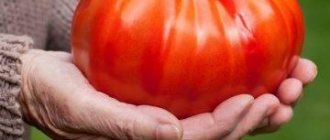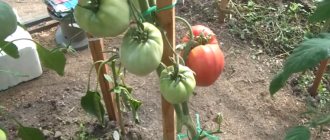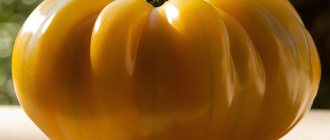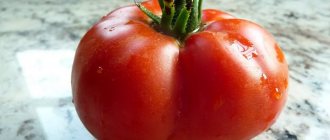Today, the sowing range of tomatoes in gardening stores is so large that sometimes it is very difficult for a simple gardener to choose a variety that will not only have high yields and excellent taste, but will also be easy to care for. These are the qualities that the Orange German Strawberry tomato has, which will be discussed in our article.
The appearance of the variety
The German Orange Strawberry tomato belongs to the genus of so-called relict (hereditary) plants and was created by German gardeners more than fifty years ago. This means that this variety is not a hybrid. Plants classified as relicts have excellent consumer qualities, primarily in terms of taste.
The Orange Strawberry tomato has been passed from hand to hand, from generation to generation, so it is several times superior to hybrid varieties in resistance to chemicals and various diseases.
Over so many years of cultivation, this variety has acquired a reputation as a tasty and unpretentious tomato, which you will undoubtedly want to plant again.
Advantages and disadvantages of the variety
Let's start this section with the many benefits:
- possibility of breeding in all regions;
- the ability to form ovaries in any conditions;
- high fruiting rate;
- strong immunity to diseases;
- unpretentious care;
- extended fruiting;
- excellent taste of fruits;
- unusual shape;
- versatility in cooking;
- long storage;
- possibility of collecting seeds yourself.
Negative characteristics include obligatory gartering, bush formation and pinching.
Tomato Orange Strawberry: variety description
The Orange Strawberry plant belongs to the indeterminate type. This is a tall bush, sometimes up to 2-3 meters, with original beautiful bright orange heart-shaped fruits and narrow green leaves. It is worth noting that Orange Strawberry (tomato) has different descriptions. Depending on the seeds purchased, the fruits can be either heart-shaped or cone-shaped.
However, the Orange Strawberry tomato variety is attractive not only in appearance, but also in taste. German Strawberry is a fleshy, juicy variety that has sweet, fruity notes combined with a slight sourness. The fruits are large, 300-600 grams, practically without seeds.
German Strawberries ripen together, in small groups of 8-10 pieces. The yield is average, you can collect 5-8 kilograms from a bush. It can be grown both in a greenhouse and in open ground. Fruiting is long, from July to October.
Harvesting and application
The mid-season variety ripens in late July – early August. Thanks to extended fruiting, vegetables are harvested until October. When harvesting, cut off the entire fruit cluster.
The purpose of ripe tomatoes is universal: from summer salads to winter preparations. To give canned juices a richer color, add red tomatoes. Yellow vegetables are great for baby food and diet meals.
Ripe vegetables retain their presentation for a long time and withstand transportation well over long distances.
Preparatory work
Any gardener knows that the success of good seedlings lies in the right soil. Therefore, in order to grow an Orange Strawberry tomato, you must first prepare the soil for planting the seeds.
As a rule, well-fertilized and loose soil is used for these purposes. You can purchase a ready-made mixture, or you can prepare it yourself. Experienced summer residents advise sowing tomatoes in loamy soil with the addition of compost or humus. To keep the substrate loose, add sawdust or peat.
There are several rules for preparing the soil for planting tomatoes.
- Before use, the earth is sifted. This will help get rid of unwanted weeds, worms and grubs.
- To protect yourself from all kinds of diseases and pests, the soil is frozen or steamed.
- To enrich it with the necessary minerals, you should add urea, humus, superphosphate or ash.
Another good option for growing seedlings is peat tablets. You can place 3-5 seeds in them. A distinctive feature of such tablets is that they do not need to be spiked.
How to grow tomatoes
Seedlings are planted in the garden in mid-May (in a greenhouse) - early June (open ground) after a constant above-zero temperature has been established.
Landing
Tomatoes are planted on the south or southeast side of the garden. Choose a place where cucumbers, zucchini, dill, and parsley grew. Crops of the nightshade family (tomatoes, potatoes, sweet peppers) are poor predecessors, since these plants are susceptible to similar diseases and suffer from the same harmful insects. The minimum distance between tomato bushes is 50 cm.
Care
The bushes are watered only with warm, settled water. With each watering, weeds are weeded and the soil is loosened. Fertilize 3-4 times during the summer, alternating mineral and organic fertilizers.
The variety is indeterminate, so pinching is carried out in one stem. Tall bushes (120-250 cm) need staking.
To avoid rotting tomatoes, the bottom leaves are torn off.
Features of cultivation and possible difficulties
Experienced gardeners carefully monitor the formation of the ovary - deformed flowers are removed to stimulate the growth of a good ovary and thereby increase productivity.
If not properly cared for, the fruits may develop a “non-strawberry” shape. In this case, change the frequency of watering and fertilizing.
Diseases and pests
Manufacturers claim that the variety does not suffer from pathogenic infections. However, in practice, especially in cool, rainy summers, tomatoes often suffer from late blight, brown spot, and gray rot.
To prevent fungal diseases, the soil is spilled with a hot solution of potassium permanganate before planting seedlings. Biological and chemical preparations will help prevent and reduce the spread of fungal diseases:
- "Fitosporin";
- "Ecosil";
- "Fundazol";
- "Quadris";
- "Ridomil Gold".
Sick plants are destroyed immediately to avoid contamination of the entire planting. Green fruits can be removed and disinfected in hot (+60 degrees) water for 2-4 minutes. Garden tools are also treated with drugs.
Bushes are regularly inspected for the presence of harmful insects. If they are detected, tomatoes are treated with special chemicals according to the instructions. The Colorado potato beetle, whitefly and cutworm are destroyed with “Oppercut” or “Aktara”. But they do this only before the ovary appears.
There are also folk, but well-proven ways to combat tomato pests. For example, thrips, spider mites and whiteflies are afraid of a decoction of celandine, slugs are afraid of ammonia, and aphids are afraid of a solution of laundry soap.
Planting seeds
It is recommended to sow Orange Strawberry tomatoes for seedlings in greenhouses in mid-March. Early April is suitable for open ground. After sowing, the first shoots should appear within a week. Thus, by the end of May - beginning of June, the seedlings can be transplanted.
Before planting, it is advisable to soak the seeds in potassium permanganate or hydrogen peroxide for disinfection, as well as in a growth stimulator.
The prepared soil should be slightly moistened, and then the seeds should be deepened by 1-1.5 centimeters. If large containers are used to grow seedlings, the distance between seeds should be approximately 5 centimeters. After the Orange Strawberry tomato seeds are placed in the soil, the container is covered with glass or film and placed in a warm room with a temperature of 22-25 ° C.
As soon as the first shoots have sprouted, the seedlings must be placed in a well-lit and slightly cool place. The temperature should be 15-16o C. After a week of this regime, the temperature is increased to 20o C during the day and to 17-18 degrees at night.
In the first days, watering is carried out with slightly warm water, every time the soil dries completely. After a full-fledged leaf appears, the tomato is watered once a week. At the same time, you can make a pick. And after the seedlings have produced five or more leaves, water once every 3-4 days.
Tomato care
The yield of the German Orange Strawberry variety depends on the quality of care for it. Also, the taste and shape of the fruit may depend on the careful attitude towards this crop. If it is not sweet and small enough, then you need to reconsider the rules for growing it.
The correct temperature during cultivation on the windowsill affects the development of shoots that are prepared for transplanting into the ground. During seed germination, it is usually at least 22 degrees, and then make sure that the temperature is 17-20 degrees.
High-quality watering with non-cold water. You can pour water into the barrel in advance, or water it with rainwater. Tomatoes love water, but it is important not to overwater. Maintaining the desired level of humidity is an important maintenance requirement.
Feeding with various fertilizers at certain times. There are times when fertilizing should be applied: this is before planting, during the flowering period, and when the tomatoes begin to ripen. These should be both mineral and organic fertilizers purchased in the store. The soil must contain humus, manure, peat, and sand.
See also
Characteristics and description of the tomato variety: Its yield is lickable Read
Loosening the soil and removing weeds. You need to do this once every two weeks, so the grass grows quickly and takes away nutrients from the tomatoes, preventing them from growing. And loosening and hilling the soil helps water and nutrients penetrate faster.
Plants may not have enough light. To do this, you need to tear off excess foliage and plant bushes further away from each other. Also, do not plant other tall plants nearby.
It is important to trim the stepsons before flowering so that the fruits ripen faster and there are more of them.
Pest control is very important for vegetable crops. It is necessary to prevent various bugs, mites, slugs, and butterflies from ruining the tomatoes. For prevention, periodically spray the bushes with various means that create uncomfortable conditions for uninvited guests.
Transplantation into the ground
Orange Strawberry tomatoes can be planted in the ground in early May, by which time the seedlings have all the necessary characteristics to successfully undergo transplantation.
Plants should be placed so that they are 1.5-2 centimeters above the ground level. It is best to replant a tomato with a clod of earth in which it grew. After planting, the plants are watered from below so as not to damage the leaves. The planting density of German Strawberries for open ground is 3 plants per square meter, and for a greenhouse - 2 plants.
For better yield in greenhouses, it is recommended to form the plant into one stem. Pruning should be done once a week. In this case, the side stems are removed and the top of the plant is tied up.
You should also remove damaged lower leaves in a timely manner. This will ensure normal air circulation and help reduce the incidence of gray mold.
Watering and fertilizing
Watering should be moderate. The soil should not be over-watered or allowed to dry out.
The best fertilizers are mineral fertilizers, compost, and humus. You should not get carried away with nitrogen fertilizers or increase the dose of any fertilizing - in this case, the plant begins to “fatten”: build up green leaf mass instead of forming fruit clusters.
Tomato "Cherry Strawberry F1" is quite easy to grow and care for. Important: regularly inspect the plants for diseases or pests, water them on time and in moderation, ventilate (if tomatoes grow indoors), weed, feed a little and - don’t forget to harvest!
Good weather and great harvest!
Disadvantages of the variety
The Orange Strawberry variety does not have any significant disadvantages, but it does cause some inconvenience when growing. They consist in the fact that it needs to be shaped, since the bush is quite voluminous and tall. As a rule, in greenhouses, German Strawberries are grown in one stem. If planted in open ground, pinching may not be carried out.
Gardeners also note that this variety is very dependent on fertilizing. If you grow it on poor soils, there is a possibility of a decrease in yield.
Features of cultivation
Orange Strawberry tomatoes do not require special growing conditions.
The variety belongs to the mid-season type, so it should be sown no earlier than March, calculating the dates for your region.
Planting seedlings in the ground for the middle zone - no earlier than mid-May, when the soil warms up to 16 °C.
After sowing the seeds, remove the container to a warm place, not lower than 25 °C, and as soon as the seeds hatch, move them to the light and maintain the temperature at 15–16 °C for 7 days, then increase the temperature to 20–22 °C.
When the first two leaves appear, transplant the seedlings into larger boxes or separate containers, not forgetting to feed them with superphosphate and potash fertilizers.
When picking, remove weak seedlings immediately, don’t be sorry! And don’t take seedlings from your neighbors, as they most often give you the most inconspicuous, unnecessary leftovers. Do you need it?!
In indeterminate varieties, the first flower cluster appears no earlier than the eighth leaf, so the main task is to prevent the seedlings from stretching.
During this period, create at least 16 hours of daylight using fluorescent lamps or “phytolamps”.
To enhance root growth, plant in high pots, and as the bush grows, add soil. The land is also important: it must be fertile and neutralized.
Plant in pre-prepared holes: 1 liter of sifted ash, 1 liter of humus, two spoons of superphosphate. Water the hole well and sprinkle mulch on top.
Do not fertilize or treat plants for two weeks.
Pests and diseases
Orange Strawberry is a fairly old variety, and therefore it is not very susceptible to the main diseases of nightshades. However, this does not mean that the variety does not need to be looked after at all. For preventative purposes, before planting, you can treat the soil with hot water with the addition of potassium permanganate. And during an outbreak of late blight, spray with preparations containing copper.
The most common pests, such as spider mites, thrips or whiteflies, can be controlled using celandine decoction or insecticides.
The Orange Strawberry tomato is a variety that many gardeners enjoy.
Reviews
Nina: “I grew it in a greenhouse, the bush grew up to 2 meters. I got an average harvest, but what a delicious taste. All the tomatoes grew in the shape of a heart. I definitely advise others to plant this variety.”
Oleg: “The bushes need to be tied up, but the result is worth it. An excellent variety that will appeal to lovers of large-fruited tomatoes. I grow only 2 bushes, but this is enough to be content with sweet tomatoes for a long time.”
“Orange strawberries” deserve their place of honor in every garden, both in the garden and in the greenhouse. Even an inexperienced gardener can handle it. It is better to collect seeds for planting yourself, which will allow future tomatoes to absorb the best qualities of the mother plants.











